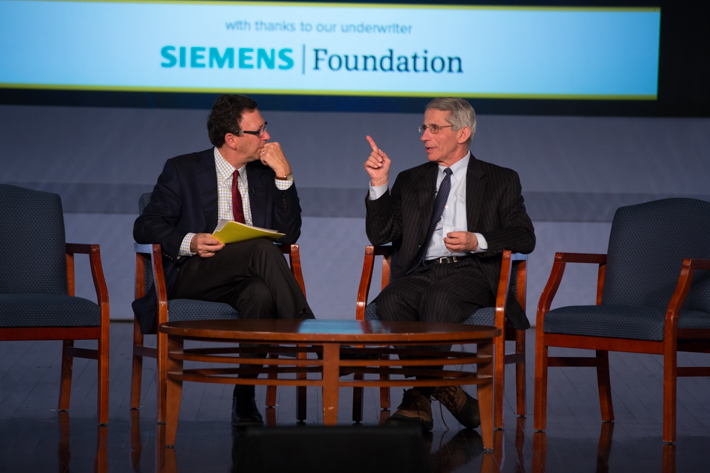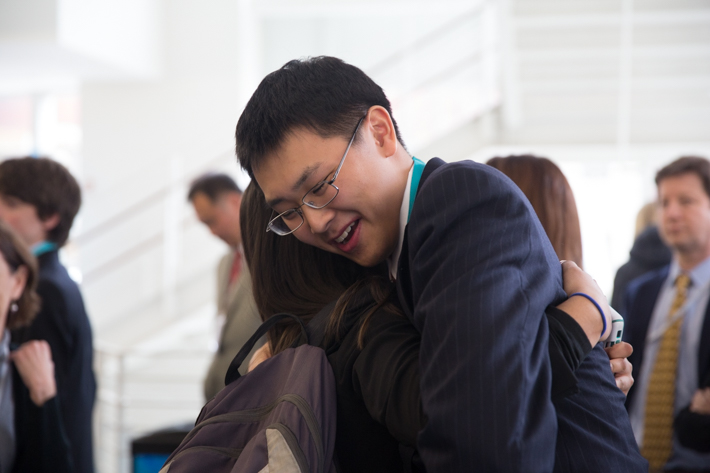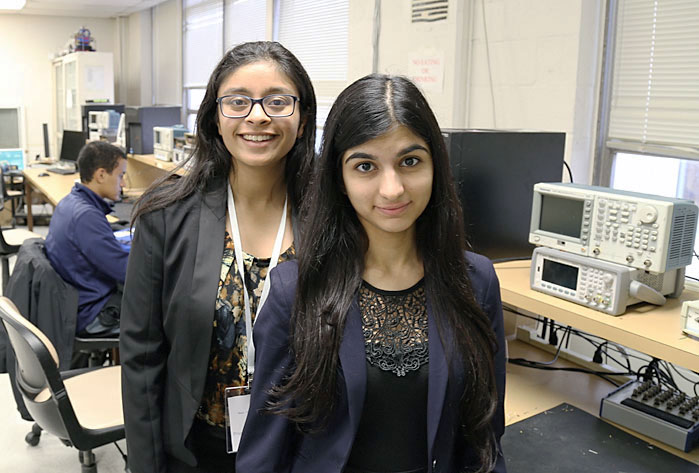Chosen from a record 2,263 applicants, Peter Tian—a high school senior from Hilliard, Ohio—captured the $100,000 grand prize at the 15th annual Siemens Competition for his mathematical research that could help drones and self-driving cars to better navigate their environments.
“First, I was in disbelief, then I was surprised because there were so many other great individual projects,” Mr. Tian said following the awards ceremony at Jack Morton Auditorium on Tuesday.
For the fifth consecutive year, the George Washington University welcomed 20 of the nation’s brightest high school students at the premier science, technology, engineering and math (STEM) competition, hosted by the Siemens Foundation.
Mr. Tian’s research project makes advancements in the theory of pattern avoidance for higher dimensional matrices, a subject that could help compute the shortest paths among objects in space. Co-founder of his school’s math club, he said he ultimately would like to become a mathematics professor, and he is inspired by the ways that math can apply to engineering and science.
Prior to the awards ceremony, Siemens and the Atlantic hosted an event, called “Full STEM Ahead,” focused on how schools, policymakers and employers can better inspire and support students—particularly young women and minorities—who wish to enter STEM fields.
A packed audience heard from science superstars like Anthony Fauci, director of the NIH’s National Institute of Allergy and Infectious Disease, and Aprille Ericsson, a pioneering African American aeronautical engineer at NASA, among many others.
“I liked the idea of discovering things that I didn’t know. There’s a certain rush about that,” Dr. Fauci said about his introduction the sciences.

SMPA Director Frank Sesno (left) interviews Dr. Anthony Fauci, director of the NIH’s National Institute of Allergy and Infectious Disease, during a "Full STEM Ahead" event hosted by the Siemens Foundation and the Atlantic.
Siemens awarded the $100,000 team prize to Eli Echt-Wilson and Albert Zuo, from Albuquerque, N.M., for their computer model that simulates how a tree grows in varying conditions. The detailed model has the potential to improve long planting experiments, as well as to maximize the efficiency of tree plantations in order to slow the effects of climate change.
In addition to the students’ research presentations and awards ceremony, the five-day Siemens Competition included a tour of the new Science and Engineering Hall, as well as meet-and-greet sessions with students and faculty from the School of Engineering and Applied Science. This year’s competitors also met with last year’s team category winners—Zainab Mahmood and Priyanka Wadgaonkar—who are now freshmen at GW.
The purpose of the Siemens Competition, according to SiemensUSA President Eric Spiegel, is to motivate and inspire the next generation of scientists and innovators. But its comparable mission is to build awareness about the emerging need in the United States for more young people to enter STEM fields.
If this year’s competition is any reflection of the nation’s STEM climate, then things seem to be moving in the right direction. Siemens saw a 12 percent increase in the number of applicants for this year’s contest. Of those applicants, 47 percent were female.
“It’s really important for the future of our economy, for the future of society at large, and it’s important for a company like Siemens, with 360,000 employees. We need more STEM graduates,” Mr. Spiegel said. “At Siemens, we really understand the link between education and innovation and that it has far-reaching implications for what we can do as a business and a society.”
Aligning with this theme, the Atlantic’s “Full STEM Ahead” event highlighted the critical need for funding to bring STEM workers into teaching positions, as well as for other educational resources, like lab equipment. Editors from the Atlantic interviewed a diverse cast of speakers, including Russell Shilling, the executive director of STEM Initiatives at the U.S. Department of Education and U.S. Rep. Aaron Schock (R-Ill.).
Dr. Shilling and other experts stressed that female and minority students often “self identify” as being poor at math at an early age, and there needs to be a greater effort to crush these stereotypes.
School of Media and Public Affairs Director Frank Sesno took the stage with his longtime friend, NIAID Director Dr. Fauci. Throughout his career, Dr. Fauci has developed strategies for patients living with HIV/AIDS as well as for treating formerly fatal diseases such as Lymphomatoid granulomatosis. He said he never could have predicted that HIV would “fall into” his lap, which was followed by a barrage of emerging infectious diseases, like SARS, West Nile Virus, Anthrax and pandemic flu.
“It’s an extraordinary dynamic of things that you trained for and the complete unpredictability of the field of health and science,” he said.
Dr. Fauci was among the team of doctors who treated Nina Pham, the nurse from Dallas who contracted Ebola in the fall. He said Ebola can be halted in West Africa if health care workers are able to “turn off the source,” even with the extreme lack of resources in the affected countries. An Ebola vaccine will be ready to begin testing in West Africa in January, he said.
“The immune system can handle Ebola pretty well. All you need to do is to keep the patient alive enough for their immune system to clear the virus,” he said. “What we need to do now is to build on the body’s natural immunity.”
Dr. Fauci said that while the principles of science have not changed throughout his lengthy career, “how you get there” has. With new discoveries and emerging technologies, science has become increasingly collaborative and interdisciplinary. It no longer exists in a vacuum.
“It’s impossible to keep up with all the advances,” he said. “It isn’t an ‘aha!’ moment in your lab alone.”
He also reminded students to keep an open mind when experimenting and to look at data in an “unprejudiced way.” Rather than discarding results that don’t fit with a hypothesis, Dr. Fauci assured the young scientists that the best innovations often come from unexpected results.
And what’s the most exciting thing for young scientists today?
“The extraordinary gratification and the charge,” he said. “It’s almost as though you never have to take a drink or a drug for the rest of your life.”
Video highlights from the full event can be viewed at the AtlanticLIVE.



